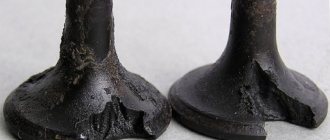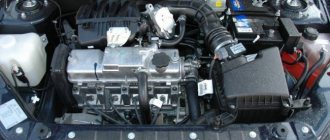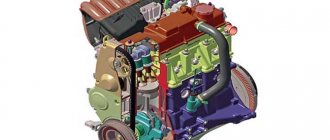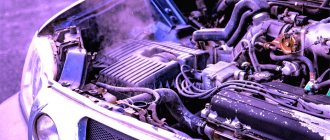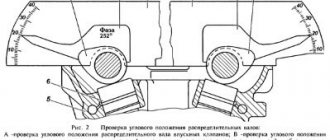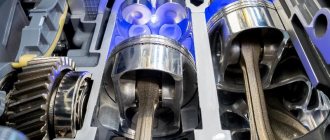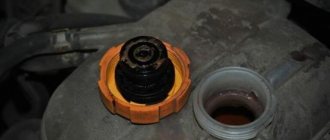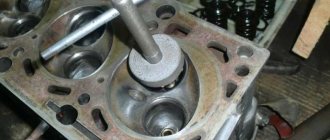VAZ cars of the 2112 family were produced with one of four engines. Two of them are 8-valve, two more are 16-valve. 8-valve engines have pistons with grooves, and therefore the valves cannot bend. But this property does not apply to any Lada passenger cars: almost all 8-valve engines began to bend their valves when moving to the Grant family. It is known which of the VAZ-2112 engines never bends the valves - the engine 21124 (1.6 16v) remains .
Look how difficult it is to change valves on the Ten. All steps in one video
Bent valves on LADA due to a broken timing belt: who should be afraid and who should not?
At one time, a torn timing belt led to frequent breakdowns of power units of classic AvtoVAZ models, and in some cases it could bend the engine valves, and this was already fraught with serious problems, including major repairs.
However, the Russian automaker has long since eliminated this vulnerability, and only buyers of used cars may encounter the problem. The latter are recommended to first familiarize themselves with the list of models that do not face this problem and only then conclude a deal.
According to industry experts, the problem of bent valves is not a problem for owners of VAZ 2108, 2109, 21099, 2113, 2114, 2115, 2110, 2111, 2112 models. Newer cars (for example, Lada Kalina, Priora and Largus) even have official protection from this vulnerability.
For other models of the Russian brand, if the timing belt suddenly breaks, there is a risk of serious damage to the power plant. However, on the Internet you can find many “collective farm” ways to protect valves from bending. Of course, they are far from official protection, but, according to experienced motorists, they cope with their task, and nothing more is required.
For example, one such method is to install plug-inless pistons that have special recesses. In emergency situations (that is, if the timing belt breaks), the parts simply fall into these recesses, which reliably protect them from deformation.
However, the most effective protection is regular maintenance and replacement of a worn timing belt. This does not require a lot of time and money, but it will protect you from serious consequences.
Source
Characteristics of motor 11183
The official AvtoVAZ manual contains a description of the parameters of the ICE 11183, according to which the technical characteristics are as follows:
| Manufacturer | AvtoVAZ |
| Engine brand | 11183 |
| Years of production | 2004 – … |
| Volume | 1596 cm 3 (1.6 l) |
| Power | 60 kW (82 hp) |
| Torque moment | 120 Nm (at 2700 rpm) |
| Weight | 112 kg |
| Compression ratio | 9,8 |
| Nutrition | injector |
| Motor type | in-line |
| Injection | electronic multipoint |
| Ignition | modular |
| Number of cylinders | 4 |
| Location of the first cylinder | TVE |
| Number of valves on each cylinder | 2 |
| Cylinder head material | aluminum alloy |
| Intake manifold | plastic receiver, electronic throttle |
| An exhaust manifold | combined with catalyst |
| Camshaft | from 21114 |
| Cylinder block material | cast iron |
| Cylinder diameter | 82 |
| Pistons | ordinary |
| Crankshaft | original with increased crank stroke |
| Number of main bearings | 5 |
| Piston stroke | 86 mm |
| Fuel | AI-92-95 |
| Environmental standards | Euro-3 |
| Fuel consumption | highway – 6.2 l/100 km |
Why does the valve bend?
First, a little theory. The number of valves in an internal combustion engine can be different (up to 32), but we will consider 8 and 16-valve engines, of which 90% are on our streets.
Timing device
The valves serve to supply a combustible mixture into the cylinder and remove gases after the piston stroke. The camshaft controls their opening and closing. The latter, in turn, is driven by the crankshaft (in our case, by means of a belt). We will not go into detail about what gaps should be between the cams and how the depth of valve stroke affects the operation of the internal combustion engine. Just know: the intake and exhaust valves must open and close in strict accordance with the current engine stroke. Below we will leave a short video explaining the operation of the internal combustion engine.
If the drive breaks, the connection between the camshaft and crankshaft is lost. What's happening? The first shaft stops abruptly, the valves “freeze”. But the second one continues to rotate due to inertia. Accordingly, the pistons move upward. Reaching the top “dead” point, the piston bottom simply breaks the plate and stem of the stuck valve.
Consequences of a broken belt
This happens in each cylinder - somewhere to a greater extent, somewhere to a lesser extent. But there is only one outcome - the ejection valve. If, when the timing belt breaks, only the valves are replaced, congratulations! You are lucky. Usually it is necessary to carry out a major overhaul of the engine: the pistons, connecting rods, camshaft and even the cylinder head are replaced.
A non-obvious cause of bent valves is a jammed water pump. Some people simply forget about it when they change the timing belt. Yes, the pump lasts longer (120-200 thousand), but it still does not last forever. The best way to protect yourself is to replace the pump at the same time. If it jams, the engine will suffer a double blow - overheating and bending of the valves. There will be nothing to restore after this.
Failure to comply with maintenance regulations when servicing the timing belt can also cause valve bending. For domestic cars, the belt replacement schedule is 60 thousand kilometers. For foreign cars - from 90 to 180 thousand (but it is better to change at 90-120 thousand).
The belt is a consumable item, and over time it loses strength. The rubber becomes hard and cracks appear. The cord stretches and tears appear in places. All this increases the chances of the timing belt breaking (or at least jumping a couple of teeth).
Gear transmission:
- gear housing failure;
- chipping of teeth.
Consequences of a broken timing belt
Some inquisitive motorists are interested in the question: is it possible to bend the valves with a starter? The answer is easy! Just do not install the sprockets or gears according to the markings - and the key is to start! Once the engine starts, you will immediately learn to recognize the symptoms of bent valves. Although, if you don’t “miss” too much, then everything can be corrected by assembling the timing drive according to the rules. If just one valve is bent, the engine will run rough. Even if it is a V-shaped “six”, you will hear it. If, after restoring the camshaft drive, the engine runs smoothly and develops the same power, then you are lucky and the manufacturer prudently supplied pistons with sufficient recesses in the bottoms. But, unfortunately, this is not always possible. First of all, when designing a motor, the designer strives to combine many seemingly contradictory qualities of his “brainchild”. For example, such as efficiency and power. This may, to some extent, justify the fact that on 16-valve engines the valves often bend when the timing belt breaks.
Such problems are especially acute for the creators of diesel engines, in which compression and the necessary swirl of the fuel mixture determine the power characteristics. Therefore, the combustion chamber is located at the bottom of the piston and often has a whimsical shape.
On diesel engines, valves bend more often than on gasoline engines.
However, behind this lies the precise calculation and modeling of vortex flows on a computer. Such chambers are called undivided and making recesses for the valves is impractical from the point of view of high-quality atomization and maximum efficient combustion of the fuel mixture. The piston is almost close to the head of the block. Therefore, it is not yet known for certain whether there are diesel engines on which “the valves do not bend.” Although, perhaps, human genius dealt with this disaster.
Why do valves bend on some cars and not on others?
How many times have owners argued about whether a valve bends or does not bend when the timing belt breaks. On the same model, with the same engine, they can break if broken or remain intact. It's all about the pistons.
This is what a Priorovsky piston looks like, which does not bend the valve
As you can see, the bottom may have a recess. The latter can be separate for each valve, or single (one recess along the contour). Such pistons were installed on VAZ engines, and were also found on Koreans and Japanese. Now, alas, you can’t find such a piston...
And all because the notches affect the efficiency of the engine. All things being equal, such an engine will produce less power and consume more fuel.
Tuning and its influence on “stickiness”
VAZ is an excellent option for tuning a car, which is what many owners use. One of the main types of engine tuning is to increase its power, and this is done in the same way that designers use - by ensuring better filling of the cylinders with the air-fuel mixture. To do this, you just need to install a tuning camshaft instead of the standard one - with a higher cam height.
But increasing power with the help of a tuning shaft also has a negative side - the valves extend from the seats at a greater distance, which means that the likelihood of them colliding with the pistons increases when the timing drive breaks. Therefore, such tuning makes even a “risk-free” engine “plug-in”.
In order not to make the engine “risky”, when tuning it is better not to make adjustments to the timing belt design, but if you decide to upgrade, you should be prepared to constantly monitor the condition of the drive.
Finally, we note that if the engine is “plug-in”, this does not mean that it is very problematic. With timely maintenance of the timing drive, the likelihood of a breakdown such as valve bending is very low and it may not occur throughout the entire period of operation of the vehicle.
VAZ 2109 valve bent, what to do
- To the beginning of the forum
- Forum Rules
- Old design
- FAQ
- Search
- Users
The 2108 1.3 engine has a problem, if the timing belt breaks, then the valve bends, is there any way to solve this problem? Well, something like that to prevent the valve from bending?
How realistic is it to make 1.5 from 1.3?
scary.
in 2003, on a V8 1.3, the belt broke, the valves were bent, the repair cost 2500 labor + 2500 spare parts. The service center installed pistons that, when the belt breaks, do not reach the valves, and no boring was done. How and what, I don’t know the details, maybe the servicemen cheated me, then I was a teapot, but they spent the whole day on me then. After a thousand kilometers I came to them as they advised - they did the valve adjustment.
And so you need to carefully monitor the belt and change it more often.
Technical characteristics of the VAZ 11183 1.6 8kl engine
| Type | in-line |
| Number of cylinders | 4 |
| Number of valves | 8 |
| Exact volume | 1596 cm³ |
| Cylinder diameter | 82 mm |
| Piston stroke | 75.6 mm |
| Supply system | injector |
| Power | 80 hp |
| Torque | 120 Nm |
| Compression ratio | 9.6 — 9.8 |
| Fuel type | AI-92 |
| Environmental standards | EURO 2/3 |
| Type | in-line |
| Number of cylinders | 4 |
| Number of valves | 8 |
| Exact volume | 1596 cm³ |
| Cylinder diameter | 82 mm |
| Piston stroke | 75.6 mm |
| Supply system | injector |
| Power | 82 hp |
| Torque | 132 Nm |
| Compression ratio | 9.8 — 10 |
| Fuel type | AI-92 |
| Environmental standards | EURO 4 |
Why are valves needed in an engine?
First you need to study the theory. Probably every car enthusiast knows the number of cylinders in the engine of his car, but not everyone can answer the question about the number of valves. Most modern internal combustion engines can have from 8 to 16 valves. There are power units where there can be 24 or more of them. The valve is an important part of the engine timing mechanism. It is responsible for supplying the fuel mixture to the combustion chamber and for releasing exhaust gases into the exhaust system. Each cylinder has two valves: one intake, the other exhaust. In 16-valve engines, there are four valves per cylinder if the engine is four-cylinder. There are also engines with more intake elements than exhaust elements. These are three- and five-cylinder engines.
The valve consists of two parts - a plate and a rod. When the timing belt breaks, it is the rod that gets hit. The valves are driven by the action of the camshaft. It, rotating around its axis in the cylinder head, can raise and lower the valves.
The camshaft is driven by the crankshaft - these two elements in any internal combustion engine are connected to each other by a belt, gear or chain drive. Through a gear drive, the camshaft rotates inside the cylinder block. This gear rotates the camshaft in the cylinder head. Today, internal combustion engines are more common, where belts are used in the timing mechanism.
The latter have a simple design, such a mechanism is cheaper to produce. However, their reliability is significantly lower than in the case of a chain drive. The latter is more complicated - there are additional elements. These are chain guides and tension rollers.
Add a comment Cancel reply
You must be logged in to post a comment.
Often phrases flash in the conversations of car enthusiasts: “I got in for repairs, the belt broke, the valves were bent.” Of course, in such cases we are talking about the timing belt. In order to understand the causes of the “catastrophe”, let us consider in general terms the interaction of the connecting rod-piston group and the gas distribution mechanism.
This interaction is strictly coordinated, otherwise normal operation of the engine cannot be ensured.
Operating principle of the valve-piston system
Let's take the compression stroke as an example. When the piston, compressing the combustible mixture, approaches top dead center, it comes almost close to the combustion chamber (on diesel engines, to the surface of the head). If at this moment any of the valves are not closed, then loss of compression will be the lesser evil. Most likely, the valve, the rod of which is rigidly held by the rocker arm (or camshaft cam) from above, will take the impact of the piston.
The valve bends in the event of a collision between the valve and the piston
In very rare cases, the manufacturer provides recesses in the piston crown to avoid collision. From what has been said, I hope it is clear why the valve bends when the timing belt breaks: the camshaft stops rotating, some of the valves remain in the open position, being a “convenient target” for pistons moving by inertia.
The coherence of the timing with the crank mechanism is ensured by the precise installation of gears or sprockets. To do this, installation marks are made on them and on certain points of the engine.
According to the type of torque transmission, the gas distribution mechanism drive can be:
Let's look at their common malfunctions, which can lead to bending of the valves.
Timing drive device
Why do they bend?
A situation where the valves are bent can happen in any engine of any design. It does not matter how many cylinders there are in the engine and how many valves it has. The reason for the breakdown is simple, and there is only one. This is a broken belt in the drive or chain. The latter break much less often compared to belts. In the case of a chain, it stretches and the stars jump.
The camshaft stops abruptly after a timing belt breaks. The cranked one will continue its movement. Thus, the valves, which are recessed in the cylinders, will collide with the pistons when they reach the top dead center position. And since the pistons have high impact energy, they can easily bend or break open valves.
Eliminating the consequences of this breakdown is very expensive. It is necessary to remove all damaged valves from the engine. Also, the entire timing mechanism and cylinder head necessarily suffer. It is not always possible to restore the cylinder head, and then only replacement with a new one or a contract one will help.
Belt drive failures
- belt break . Can be caused by wear, as well as excessive tension and wear on the tension and parasitic rollers;
- belt slippage due to cutting of teeth or breakage of the tension roller spring (if it is provided for in the design). Cut teeth may not be immediately detectable;
- cutting off one of the gear keys or breaking the keyway;
- On some engines, the camshaft gears have a conical fit, that is, only the tightening torque of the bolt serves as insurance against gear rotation. (One master failed to get such a gear. To my question: “So what?” was the answer: “twelve out of sixteen.” This meant bent valves, of course.)
How to identify bent valves?
It is impossible to determine by eye what bent the valves. This will require simple, simple steps. First you need to install the timing belt according to the marks, and then rotate the crankshaft manually. It usually takes two to five turns to determine that the valves are actually bent. If the crankshaft rotates easily and calmly, then the timing elements are intact. When rotation is difficult, the valves are damaged.
It also happens that when the crankshaft rotates freely and easily, the valves are still bent. In this case, the problem can be identified by measuring the compression. If the compression is zero, then the timing elements are damaged. Many people do not know how to check whether the valves are bent. It will be heard. The engine will run rough. This is felt well even on large engines with six or more cylinders.
Useful tips on the topic
Following the recommendations will make life easier for the driver and the engine of his car:
- find out whether the valves in your car’s engine are bent using a table, a reference book, or with your own hands;
- Carry a spare timing belt with you;
- buy a good quality belt (it’s better to always use the same brand);
- periodically check the belt tension and conduct a visual inspection for cuts, burrs, and detachments of ropes;
- when buying a used car from a stranger, it is recommended to change the timing belt, even if the former owner said that he recently replaced it;
Let's move on to the cylinder block
We remove the pallet. Rotating the crankshaft as it is convenient for us, unscrew two bolts on each connecting rod cap. We use a TORX E10 head for this.
We take out the pistons along with the connecting rods. To do this, use the wooden handle of a hammer to press the connecting rod from below and lightly tap it to knock it up. We remove the old liners and buy new ones of the same size according to the markings on them. Here is another stone in AvtoVAZ’s garden, the owner has never climbed into the car from the interior or into the engine, but three pistons were of group “B” and one was “C”. It turns out that at the factory they re-sharpened one cylinder a little and simply put an enlarged piston there, no words. There are no options, we take group “C”, don’t sharpen the engine because of this. We will not touch the main liners either.
We buy a new piston group that does not bend the valves, connecting rods and connecting rod bearings.
Eliminating longitudinal play of the crankshaft
It was noticed on this motor. To eliminate it, replace the thrust half-rings. Standard and repair sizes are available. We take the first repair size, if they are too tight we sand them down a little. We unscrew the middle main bearing and gently push it with a screwdriver and move the half rings. The mark on it is in the form of three serifs, shown below.
When the half ring comes out a little, turn the crankshaft, it will push it out. There are two types of half rings: white at the front and yellow at the rear; the grooves on them should point towards the crankshaft cheeks.
We install them as we removed the new half rings; if they go in with great effort, you can grind them a little on a small abrasive stone, but not from the side of the grooves. Checking the play. We tighten the main bearing with a torque of 8 kgf*m.
Assembling the piston
There is an arrow stamped on the top of the piston; it should be directed towards the front of the engine. And there are marks on the connecting rod that should look the same way. Don't get confused!
We insert one retaining ring into the groove on the piston. We insert the connecting rod into the piston and, having lubricated the connecting rod and the piston pin with oil, insert it into place. Insert the second retaining ring. Although this operation seems simple, it will take some pains. We inspect the assembled structure; all retaining rings must be clearly in their grooves, otherwise a ring that has jumped out while the engine is running can cause a lot of trouble.
After assembly, you need to break off the connecting rod bearing cap, since the connecting rod is made in one piece. It's like that on our cars. First, unscrew the bolts. We insert the connecting rod into the cleats at the level of the mark shown in the figure with the black arrow and lightly clamp it, then break it off with a slight movement of the hand. The first time is very scary. We put the cover in place and tighten the bolts so as not to mix it up in the future.
Checking the thermal gap in the piston rings
We lay out each set of rings for each cylinder. In the future we will not change their places. In turn, we insert each ring into its own cylinder and push it a little with the piston approximately to the middle.
We measure the gap with feeler gauges.
Nominal clearance: 0.25 - 0.45 mm.
The maximum clearance for all is 1 mm. But this already smacks of waste.
Installing new rings
First, install the oil scraper ring expansion spring, then the ring itself. The oil scraper ring lock should face the opposite direction of the spring lock. Then we install the lower compression ring and finally the upper compression ring. The inscription “TOP” must be stamped on the rings; it must face up. The rings in the piston grooves must rotate easily.
Installation
Types of internal combustion engines, what internal combustion engines exist
Remove the standard side mirrors (pry off the mirror triangle with a screwdriver and remove the three mounting screws). Install the new mirror in the reverse order.
We stretch the turn signal wires to the mirrors:
- Remove the door trim.
- Remove the turn signal from the fender and disconnect the block. We install plugs instead.
- Pull the wires out of the fender and into the interior. To do this, unscrew the sill trims in the cabin, peel back the carpet and felt and pull the black wire in the engine panel. We determine which of the two +12 V wires using a multimeter or a test lamp. We insulate the second wire.
- Route the wire from the passenger compartment to the car door through the corrugation.
